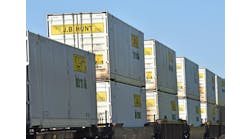Almost two decades into the 21st century, there is no doubt that e-commerce has radically and permanently altered the retail landscape for U.S. companies. But there is also no debate that e-commerce and mobile e-commerce are redefining what it actually means to be a U.S. company. In other words, even the smallest local store today can become a global player, accessing a vast audience of potential customers beyond our borders quickly and affordably, which means that location is now an entirely relative term. Consider that in 2017, American consumers spent almost $454 billion online, while around the world Internet sales reached above $2.3 trillion, and you begin to understand that the fastest road to retail growth is certainly international in scope.
To keep that road open and its traffic running efficiently, logistics strategies must evolve constantly and quickly by integrating flexibility and technological innovation in the core of every process. Ultimately, all of the investments and energy that retail companies devote to product evaluation, sales, marketing and customer engagement will amount to very little if they cannot get their goods efficiently and securely into the hands of waiting buyers. To this extent, logistics and shipping represent the final and essential factor in the equation for e-commerce success.
The work of logistics and shipping companies has already transformed dramatically to meet changing demands, with the expansion of global express delivery, online international logistics support programs, automated trade services, and real-time shipment tracking. At the same time, government agencies and business organizations are investing significantly to promote the value of exporting, offering access to Customs assistance, country-specific research, and even one-on-one international trade support. But the most important logistics challenge is still in front of us, and it involves the complex and often-discussed issue of last-mile delivery.
The potential problems involved in the last mile reflect the fact that e-commerce is, to a certain degree, a victim of its own success, with surging demand for deliveries creating the potential for bottlenecks and delays in the final stage of transit. The difficulties will continue to compound as more people around the globe move to dense, urban areas, and as seasonal demand for e-commerce products expands.
A recent study from DHL and Euromonitor International identifies four main trends that are shaping the future of urban last mile delivery. Noting that 600 million more people are forecast to live in city environments by 2030, the study analyzes the path forward for online retailers and their logistics partners in the face of changing demographics and the rise of both assistive and disruptive technologies. According to the study, the battle for last-mile success will revolve around the following issues: localized delivery, flexi-delivery networks, seasonal logistics and evolving technologies.
To succeed in the future and thrive as competition grows, companies must be constantly ready to adapt their supply chains to reflect changing market conditions and customer demands. This means not only pursuing new transportation and planning solutions, including automated delivery and artificial intelligence (AI) programs, but also new approaches to managing inventory. Here is a closer look at the last-mile challenge:
Localized Delivery
Euromonitor estimates that by 2030 there will be an additional 1 billion people on the planet. Sixty percent of those people will live in an urban environment, and the significant majority will come from today’s emerging markets. Consumers in urban areas will include more 65+ members who are healthier and wealthier, and together they will represent a more culturally diverse group. These trends suggest a continuing shift in the way that people obtain the goods they need: with space limited and convenience essential, consumers will continue the move toward online purchases and expedited delivery.
Already today, urban consumers want faster and more flexible delivery options. They not only want their products quickly, they want them delivered in a certain way and at a specific time. As a result, delivery networks are becoming more localized, shifting the supply chain strategy to focus on regional fulfillment. The goal of this localized approach is to shorten the last mile and remove barriers that stand in the way of making fast deliveries that can be customized to specific times and locations.
The move toward regional fulfillment is becoming micro-focused. Instead of a country-level localization, fulfillment hubs are getting closer to consumers, and often integrated within major urban centers. The ideal system of today and the future might be described as decentralized but pegged, with large warehouses that feed into smaller regional warehouses closer to urban centers. Achieving this model on a global scale will require significant investment, since creating more inventory storage and management in locations closer to the last mile represents a fundamental logistics shift.
One important note: As retailers and their logistics partners move fulfillment and delivery into cities, they will need to balance environmental and social impacts. Congestion and emissions are already key concerns in urban areas, and as e-commerce expands many areas may not be able to absorb the additional delivery vehicles needed. As a result, delivery networks must look for green solutions and alternative technologies that can change the fulfillment equation.
Flexi-Delivery Solutions
Consumers want to have a degree of control over when, where and how their e-commerce purchases are delivered. The bottom line is that they want to minimize the time spent waiting for a package, especially if a signature is required. Flexi-delivery options are changing the way transport operators approach the last mile. Some examples include service pick-up points, parcel lockers, bicycle delivery and electric vehicle drop-off. The goal of these solutions is to expand urban localization and meet consumer demand.
Today, logistics planners are exploring additional “out-of-the-box” methods, such as crowd sourced deliveries, ride share deliveries, and more. Same-day, one-day and two-day deliveries are growing as e-commerce rises. The ability to adapt to consumer desires, especially those of urban buyers, will likely define the success of last-mile delivery in the years to come.
Seasonal Logistics
Holidays that were once regional and local are expanding their reach, thanks to the Internet. Chinese New Year and Diwali, for instance, have joined Christmas and Valentine’s Day as important, global holidays that see a significant spike in online shopping—and of course corresponding delivery needs. Consumers are looking across borders and finding opportunities to buy in seasonal holiday times that were once confined; consider that Alibaba’s Singles’ Day for Chinese shoppers now reaches the Philippines, Thailand, Malaysia, Singapore and Vietnam. Amazon’s Prime Day has also expanded to new global regions.
The rise in global holidays has put significant stress on supply chains and logistics strategies. Delivery networks need to adapt to these instances of sporadically high orders, especially given that consumers expect fast and on-time delivery regardless of whether they are seeking a holiday present or a deeply-discounted item for personal use.
For transport operators and logistics managers, solutions to the seasonal holiday dilemma can be either permanent or temporary. Alibaba, for instance, owns an outside logistics network, Cainaiao, that has streamlined and improved order fulfillment on a consistent basis each Singles’ Day. But more elastic solutions can work as well. The bottom line, however, is that the last mile is consistently and dramatically impacted by holidays, and retailers and their logistics partners must stay ahead of the trend.
Evolving Technologies
Technology will be key in order to meet the needs of the last mile in the future. Advanced platforms and tools have already transformed the way products are moved and tracked across the globe today, and new, updated approaches promise important strides down the last mile. While futuristic ideas like automated delivery vehicles and aerial drone delivery are important, core technology progress matters most immediately. Cloud computing, AI, data collection through the connectivity of the Internet of Things, and blockchain technology promise to streamline delivery through automation.
How, specifically, can advances in technology improve last-mile delivery? Programs and platforms that are perfecting the collection and analysis of real-time data around delivery are perhaps most important today, since they are helping to boost machine learning. Ultimately, improved automation through machine learning can expand the use of robotics in warehousing, while refining inventory management and peak planning processes.
Global e-commerce is not the future we are anticipating—it’s the future that has already arrived. For it to thrive and grow in an increasing urban landscape, retailers, logistics planners and transport operators must solve the most important piece of the puzzle: the last mile. By embracing new technologies, and by adopting flexible solutions and adaptable transport methods, logistics leaders are already on the path toward delivering what consumers want, when they want it and where they need it.
Greg Hewitt is CEO of DHL Express U.S., where he is responsible for all aspects of the company’s International Express business.



